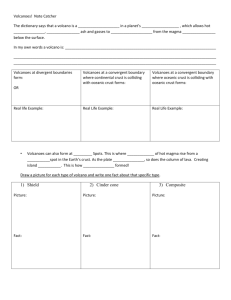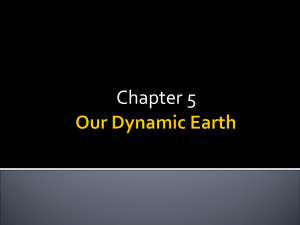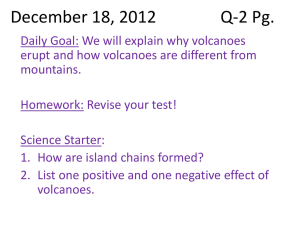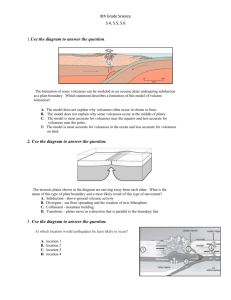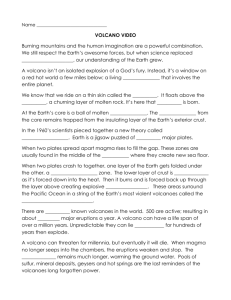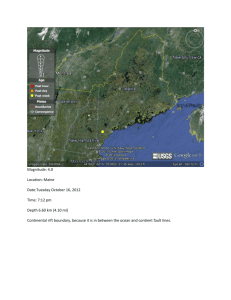Salt Lake Community College Geography 1000 – Physical Geography AJ
advertisement
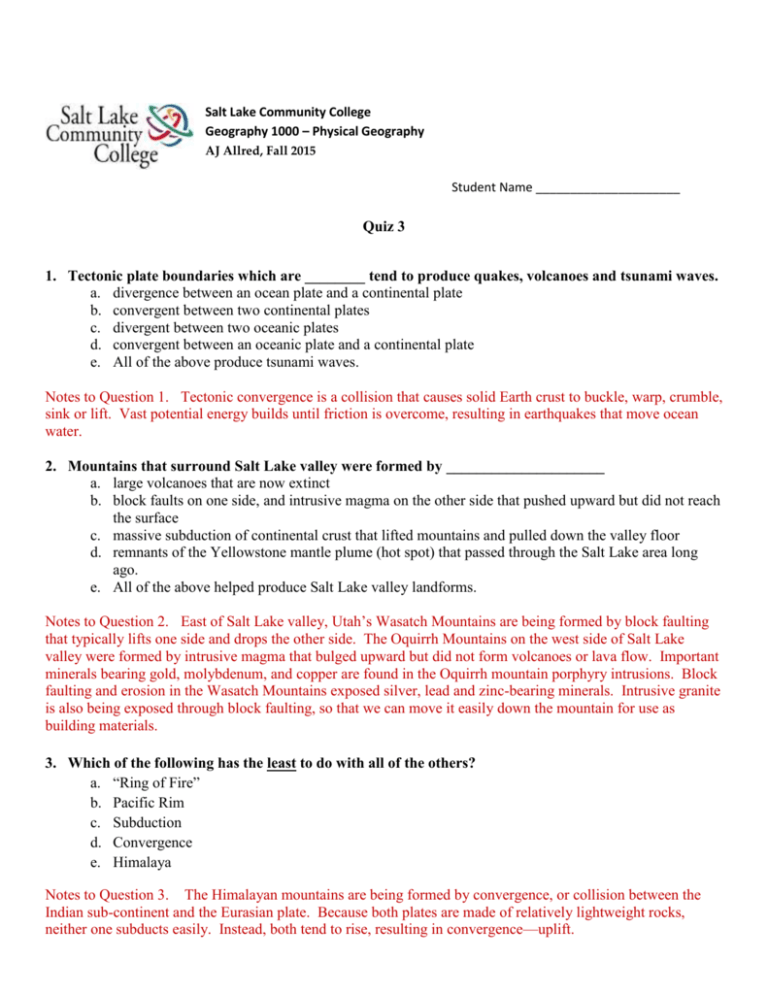
Salt Lake Community College Geography 1000 – Physical Geography AJ Allred, Fall 2015 Student Name _____________________ Quiz 3 1. Tectonic plate boundaries which are ________ tend to produce quakes, volcanoes and tsunami waves. a. divergence between an ocean plate and a continental plate b. convergent between two continental plates c. divergent between two oceanic plates d. convergent between an oceanic plate and a continental plate e. All of the above produce tsunami waves. Notes to Question 1. Tectonic convergence is a collision that causes solid Earth crust to buckle, warp, crumble, sink or lift. Vast potential energy builds until friction is overcome, resulting in earthquakes that move ocean water. 2. Mountains that surround Salt Lake valley were formed by _____________________ a. large volcanoes that are now extinct b. block faults on one side, and intrusive magma on the other side that pushed upward but did not reach the surface c. massive subduction of continental crust that lifted mountains and pulled down the valley floor d. remnants of the Yellowstone mantle plume (hot spot) that passed through the Salt Lake area long ago. e. All of the above helped produce Salt Lake valley landforms. Notes to Question 2. East of Salt Lake valley, Utah’s Wasatch Mountains are being formed by block faulting that typically lifts one side and drops the other side. The Oquirrh Mountains on the west side of Salt Lake valley were formed by intrusive magma that bulged upward but did not form volcanoes or lava flow. Important minerals bearing gold, molybdenum, and copper are found in the Oquirrh mountain porphyry intrusions. Block faulting and erosion in the Wasatch Mountains exposed silver, lead and zinc-bearing minerals. Intrusive granite is also being exposed through block faulting, so that we can move it easily down the mountain for use as building materials. 3. Which of the following has the least to do with all of the others? a. “Ring of Fire” b. Pacific Rim c. Subduction d. Convergence e. Himalaya Notes to Question 3. The Himalayan mountains are being formed by convergence, or collision between the Indian sub-continent and the Eurasian plate. Because both plates are made of relatively lightweight rocks, neither one subducts easily. Instead, both tend to rise, resulting in convergence—uplift. Around the “Ring of Fire” heavier ocean crust subducts beneath lighter-weight continental crust, resulting in massive earthquakes, volcanoes and tsunami waves. Subduction results in melting of ocean crust that sinks toward the asthenosphere, becoming molten again. Notice that with subduction, the heavier or lower crustal plate tends to be underneath ocean water, so tsunami waves can develop from large quakes. Himalayan quakes are far from ocean water. 4. Which statement is true regarding mantle plume “hot spots” in the United States? a. A mantle plume is creating a new seamount east of Hawaii that could become an island someday. b. A “hot spot” is in the process of creating several new islands west of Hawaii (Oahu, Molokai, Maui, etc.). c. Hot spot activity produced volcanic landforms in Nebraska and New York before moving westward. d. The Yellowstone mantle plume is likely to produce volcanoes in Northern Canada and Alaska someday. e. “Hot spot” movement is unpredictable. Hot spots in the United States move without any pattern or process that we understand. Notes to Question 4. Mantle plumes are relatively isolated, single points of rising magma that tend to be stable in location, compared to crustal plates that slip or migrate across the surface of the Earth. The crust underneath the Hawaiian Islands is moving westward, so the hot spot rising through the crust is located at the eastern edge of the Hawaiian Island chain. The Hawaiian Islands will continue to move westward, and a new bulge of magma is building on the sea floor east of the “Big Island”. Eventually, there is likely to be a new island in the Hawaiian chain. The same pattern applies to Yellowstone Park as the North American plate moves slowly westward, Earth crust to the east will eventually slide over the hot spot. So, continental crust located east of Yellowstone Park will eventually be subjected to “hot spot” volcanic and/or magmatic activity. In visualizing this movement, it may help to recall that New York is moving westward away from Paris, France as the Atlantic Ocean grows larger due to mid-ocean rifting. So, over time the hot spot that underlies Yellowstone Park will be intruding into crustal lithosphere that has moved over it from the east. 5. Which of the following characteristics apply to rocks that were “blown” out of volcanoes, often causing death and destruction during violent eruptions? a. Magma that is relatively hard and shiny, and not ‘sticky’ or viscous when molten. b. Heavy, dark basalt that contains little silicon and more iron and nickel. c. Magma that acts like popcorn or bubble gum when molten. d. Rocks that contain very little silicate and/or dissolved gases (water vapor, carbon dioxide, etc.). e. Answers ‘a’, ‘b’ and ‘c’ above apply to rocks created by violent eruption. Notes to Question 5. Extruded magma that is high in silicates, rather than heavy metals, will tend to be lighterweight, and viscous or sticky enough to build up pressure for explosive eruptions. Silicate lava cools into relatively crumbly material that can erode into good farm soil. Explosive eruptions are also associated with higher levels of gases and water vapor that contribute to the violence of eruptions. Gassy, silicate eruptions are also associated with large amounts of gas, vapors and aerosols that can circle the Earth, causing cooler weather for more than a year. Metallic, low-silicate magma tends to flow, rather than blow, leaving dense, hard, and dark-colored beds of lava. 6. Which of the following is not true regarding volcanoes? a. The "Big Island" of Hawaii is taller from sea floor to its peak than Mt. Everest is from sea level to its peak. b. The hazardous stratovolcanoes in Hawaii are prone to violent eruptions. People keep moving there anyway. c. Heavy, very hot magma that is low in silicates is not closely associated with violent eruptions. d. The Pacific Ocean “Ring of Fire” can be called the “Ring of Gamblers” because of population growth trends. e. Utah is not located directly on the “Ring of Fire”. Utah does have some potentially dangerous volcanoes. Notes to Question 6. The Hawaiian Islands rise from sea floor about 20,000 feet deep and then extend more than 13,000 above sea level, making them the tallest mountains on Earth. Eruptions on Hawaii’s “Big Island” are from immense shield volcanoes that are contain relatively less viscous or ‘sticky’ silicates and less dissolved gases. The result is that shield volcanoes may be large in size, but tend to produce mild “flow” eruptions rather than explosive “blow” eruptions. 7. The Himalaya, Earth’s tallest continental mountains above sea level, are being shaped by __________________. a. subduction convergence that is typical of the "Ring of Fire" b. massive transform or “slip-strike” faults that violent or horizontal earth movement c. volcanoes and earthquakes that are typical of the “Ring of Fire” d. lightweight ocean crust that rifted (diverged) onto Asia. e. Convergence of lightweight continental crust Notes to Question 7. Collision between lighter-weight continental crusts tends to produce convergence with uplift as neither formation is prone to subduction and re-melting. Erosion plays an important role as well, because tall mountains attract heavy snowfall that wears down steep landforms. The uplift caused by simple convergence between Asia and the Indian sub-continent would exhibit much higher mountains were it not for rapid erosion caused by solar forces acting with water. The Himalayan mountains are not associated with volcanoes and lava. Transform quaking involves lateral, horizontal movement, rather than vertical displacement. So, mountain-building is not typically involved with slip—strike motion during transform quakes. Rifting may produce new crustal material when upwelling of magma pushes landforms apart, such as along the Atlantic mid-ocean ridge. However, this relatively heavier new crust is not known for producing island arcs and/or tall mountains. Instead, this new crustal material moves laterally, or horizontally along the surface, pushing continents apart rather than forming new ones. 8. The difference in Magnitude (energy release) between a quake of M 6.0 and M 7.4 is calculated by which of the following methods? a. Subtract 6.0 from 7.4, yielding a difference of 1.4 times more energy. b. c. d. e. 32.0 x 2.0 x 2.0 = 128 times more energy. 6.0 to 7.0 = double (2x). Then add 0.2 + 0.2 = 2.4 times more energy 32 + 4 = 36 times more energy None of the above is a good method for estimating differences in Magnitude between quakes Note to Question 8. On a base of 32x, a 7.0 M quake releases 32 times more than a 6.0 M quake. The increment of 0.2 doubles that difference, so a 0.4 increase in magnitude results in 2 x.2 = 4 times more energy released. Adding 4 + 32 = 64 times more energy released by a quake of M 7.4 over a quake of M 6.0. 9. A ____________ fault is associated with lateral or horizontal slippage, and does not result in significant loss of crust due to subduction and re-melting. a. convergent b. block fault scarp c. divergent d. subduction e. transform Note to Question 9. During convergence between plates made of differing density will tend to cause the heavier plate to subduct or sink back into the molten asthenosphere where it remelts. A fault scarp is a vertical formation where one face is higher than the adjacent face. Divergent boundaries can produce fault scarps. Transform, (strike-slip) faults are horizontal or lateral in movement, not vertical, so fault scarps are not a typical feature. 10. About how many people around the world are living in the danger zone of an explosive volcano? a. 50,000 b. 500,000 c. 5,000,000 d. 50,000,000 e. Five hundred million Note to Question 10: About ½ billion people live on slopes below strato, or composite volcanoes that are prone to explosive “blow” eruptions. Such slopes are attractive for many reasons: farming, moderate climate, and scenic views. 11. Which of the following statement(s) help us understand Utah’s landforms? a. Mountains on the eastern side of Salt Lake valley are remnants of volcanoes that are now dormant. b. Along Interstate 15 in south-central Utah are some potentially dangerous 12,000 foot tall stratovolcanoes. c. There are no potentially dangerous volcanoes in Utah. d. Volcanic formations in Utah often contain fossil fuels. e. None of the above is true of Utah landforms. Note to Question 11: Mountains rising above the east side of Salt Lake represent major portions of the Wasatch Fault, which is part of the Intermountain Seismic Belt that runs north and south for hundreds of miles, and includes Yellowstone Park. The Wasatch Fault zone is not formed by volcanoes, but by normal block faulting or “dip slip” movement. The east-side block is rising relative to the “down-thrown” block that marks the valley floor. Fault scarps in mountains above Salt Lake expose rock formations, such as granite, that were once buried deeply as plutonic intrusions of magma that did not reach the surface before cooling and hardening. There are some genuine stratovolcanoes in Utah, and some of the most prominent are the Tushar Mountains that can be seen along the east side of Interstate 15 near Beaver and Manderfield. A large number of relatively tiny cinder cones are scattered across much of southwestern Utah. These volcanoes and cinder cones are all examples of extrusive magma that can erupt explosively at times. Geothermal hot water can be found in countless Utah locations where water seeps into the ground far enough to reach rocks that are still hot from Utah’s recently active volcanic past. 12. In the past 60 or so years, geologists reached agreement that the cause of plate tectonics is _________. a. climate and weather b. convection c. sun spots d. human activities in the “Anthropocene” or human epoch e. earthquakes Note to Question 12. Convection is the vertical movement of fluid. Molten magma rises by expansion, cools near the surface and sinks for re-melting. It is true that climate change can cause landforms to rise or sink, based on how much ice or water rests on them. However, convection is the primary means of tectonic activity. 13. California’s famous San Andreas fault system is known for everything below except ____________. a. high-magnitude earthquakes that could kill or injure thousands of people b. transform fault movement that is gradually moving the Los Angeles region northward to San Francisco c. tsunami waves and volcanoes d. fault movement that cracks sidewalks and breaks water lines e. being part of the “Pacific Ring of Fire” Note to Question 13: All of the options are true except being part of the Sierra Nevada mountains. The San Andreas is mostly transform, or slip-strike movement that does not create significant vertical scarp faces. A portion of energy released by San Andreas fault movement occurs as “creep” or slow quaking that gradually cracks sidewalks and other infrastructure. Unfortunately, some build-up of tectonic stress is not relieved by small, slow or gradual movements. So, severe quaking has occurred in the past and expected in the future anywhere along the hundreds of miles of the San Andreas fault system. 14. Utah is not safe from the effects of hurricanes. In fact, Utah landforms and climate contribute to lethal hazards that originate with hurricanes that never come close to Utah? True ____ False ____ Note to Question 14: Hurricanes do not reach Utah; however, prevailing winds can bring atmospheric moisture to Utah, sometimes leading to torrential rain, flash flooding and landslides. In 2015, a total of 20 people were killed by flash flooding in Utah that originated with hurricane winds that moved tropical water into our region. Utah’s steep, dry and hard land forms tend to concentrate rainfall run-off, leading to flash flooding. Saturated soils are vulnerable to failure: slumping, creeping, falling, and sliding. 15. Which statement below is accurate regarding landform processes in the Salt Lake area? a. Geologists are able to drill into Earth’s asthenosphere and mantle for information that explains how tectonic forces work. b. Salt Lake City is safe from salt water flooding caused by an earthquake. c. Granite rocks that we use for counter tops and other building materials were produced by volcanoes that “blow” instead of “flow”. d. Scientists believe that faults near the SLCC Redwood campus could slip or rupture, releasing as much energy as several atomic bombs exploding somewhere below the surface. e. Radioactive decay of uranium into lead produces solar energy that tends to wear down Earth land forms. Note to Question 15. No one has drilled through the Earth’s crust into the asthenosphere and/or mantle. Pressure and temperature are high enough to melt even the strongest, hardest drill tool. Granite is a plutonic, intrusive rock formation that does not reach the surface before cooling into large, hard crystals. Quaking and erosion can expose granite at the surface, where we can cut it for use in buildings. Ground faulting near SLCC Redwood campus can produce substantial earth quaking, up to M 7.0. By general comparison, an earthquake of M 4.0 releases roughly as much energy as an atomic bomb. A limited amount of research indicates the potential for Great Salt Lake water to inundate urban areas during a severe earthquake. The valley floor could tilt during a quake as the Wasatch Mountains (hanging wall) slips upward and the valley floor (foot wall) slips downward. It is also true that as the Great Salt Lake evaporates toward its lowest recorded level, there is less likelihood of water intrusion during a quake.

